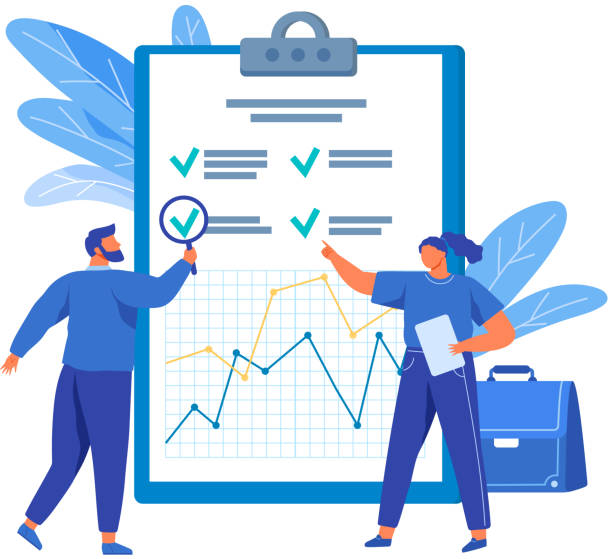In today’s digital age, an online presence is more crucial than ever for any business or company.
#Corporate website design is no longer a luxury, but an undeniable necessity for effective communication with customers, showcasing services and products, and building credibility in the market.
A corporate website is your company’s virtual storefront, accessible to a global audience 24/7.
This not only creates new opportunities for marketing and sales but also allows companies to surpass their competitors.
Successful #business website design should not only be visually appealing but also functional, fast, and search engine optimized (SEO).
These websites bridge the gap between the company and its target audience, providing comprehensive information, receiving feedback, and even enabling online transactions.
Without a strong digital presence, companies may lose a significant portion of their market potential and fall behind more modern businesses.
The importance of proper web design for companies goes beyond a digital business card; it is a strategic tool for long-term growth and sustainability.
The design of a corporate website is a complex, multi-stage process where each step requires precision and expertise.
The first step is a complete understanding of the business objectives and target audience.
This stage includes competitor analysis, content strategy definition, and identification of user needs.
Following this, it’s time to plan the website structure (sitemap) and design wireframes (initial visual design), which form the basis of the user experience (UX).
In the next stage, user interface (UI) design takes place, which includes selecting colors, fonts, images, and all the visual elements that make the website beautiful and attractive.
After the design is approved, the development and programming stage begins, where back-end and front-end coding is performed, and the various website features are implemented.
Finally, the testing and debugging stage ensures the website functions correctly on all devices and browsers, after which the website is uploaded and launched on the server.
These steps ensure that the final website is not only visually striking but also technically powerful and stable.
Choosing the right platform and expert team for corporate website design is a vital decision that directly impacts the success and efficiency of the project.
There are various platforms for building corporate websites, each with its own advantages and disadvantages.
WordPress, as a popular content management system (CMS), offers high flexibility and ease of use, while custom development is more suitable for projects with very specific needs.
Choosing a design team is equally important; a team that not only has strong technical and design skills but also a deep understanding of your business goals and can offer creative and effective solutions.
Reviewing portfolios, reading previous customer reviews, and interviewing the team can help you make the best decision.
In today’s competitive world, corporate website design without considering #user experience (UX) and #user interface (UI) is doomed to fail.
These two concepts are the main pillars of a successful website that directly impact user satisfaction and, consequently, conversion rates.
User experience refers to the user’s overall feeling when interacting with the website; Is the website easy to navigate? Is the required information easily found? Are the pages loading fast? Good UX keeps users on the site longer, visits more pages, and increases the likelihood of their return.
In contrast, the user interface addresses the visual and interactive aspects of the website; including the arrangement of buttons, forms, colors, fonts, and all visual elements.
An attractive and user-friendly UI makes the website beautiful and pleasing, encouraging users to interact more.
The professional team responsible for creating a website for your business must strike a precise balance between beauty and functionality so that users are not only visually attracted but also have a smooth and enjoyable user experience.
It is this coordination between UX and UI that transforms a website from merely an online presence into a powerful marketing tool.
After corporate website design and launch, the next step to visibility and customer acquisition is #search engine optimization or SEO.
Without SEO, even the most beautiful and user-friendly website may get lost among a multitude of other websites and be difficult for the target audience to find.
SEO is a set of techniques and strategies aimed at increasing the website’s ranking in organic Google search results and other search engines.
This process includes keyword research, content optimization, improving site loading speed, building high-quality backlinks, and ensuring a healthy technical website structure.
A commercial website design that is done from the outset with SEO in mind will have a high competitive advantage.
This means optimized coding, using appropriate title and meta description tags, and a friendly URL structure.
By focusing on SEO, your company can attract high-quality, targeted traffic, leading to increased visibility, credibility, and ultimately, business growth.
Ignoring SEO means missing out on one of the most powerful digital marketing channels.
Content is king, and this statement is entirely true for corporate website design.
A website without valuable content is like an empty storefront.
Producing engaging and effective content not only helps attract an audience but also strengthens SEO, enhances brand credibility, and converts visitors into loyal customers.
Content can include blog articles, product and service descriptions, image and video galleries, case studies, customer reviews, and even podcasts.
#High-quality content should be informative, relevant to the audience’s needs, and up-to-date.
In the process of designing and launching a company website, a content strategy should be developed from the outset and continuously updated with fresh and engaging content.
This means a deep understanding of customer personas, relevant keywords, and providing solutions to audience challenges.
Video content and infographics can also play an important role in keeping users on the site due to their visual appeal and ease of information transfer.
The ultimate goal of content creation is to build meaningful relationships with the audience and encourage them to take the desired action (such as buying or contacting).
After investing in corporate website design, maintaining its security and regular maintenance is as important as the design process itself.
#Website security protects sensitive company and customer information from cyberattacks, malware, and unauthorized access.
Data breaches can not only cause significant financial damage but also irreparable damage to the company’s reputation and credibility.
Security measures include using SSL certificates, regularly updating the platform and plugins, using web application firewalls (WAF), regularly backing up data, and constantly monitoring suspicious activities.
In addition to security, #website maintenance also includes technical updates, speed optimization, checking broken links, and ensuring website compatibility with the latest browser and device versions.
A slow-performing or buggy website can severely disrupt the user experience and lead to losing customers.
Therefore, budgeting for maintenance and security alongside the cost of corporate portal design is essential to ensure the longevity and efficiency of your website.
The digital world is rapidly changing, and #future web trends will have a profound impact on corporate website design.
Companies must adapt to these changes to succeed in the future.
One of the most important trends is the increased focus on mobile-first design, meaning that websites are designed first for the user experience on mobile devices and then optimized for desktops.
Artificial intelligence (AI) and machine learning are also changing how users interact with websites; from advanced chatbots to personalized content suggestions.
Voice search is also gaining popularity, and websites must be optimized to respond to these types of searches.
Also, attention to web accessibility for people with disabilities is becoming increasingly important.
Future corporate websites will increasingly move towards interactivity, personalization, and the use of emerging technologies such as augmented reality (AR) and virtual reality (VR).
To ensure the sustainability and competitiveness of your company website launch, you must constantly monitor these trends and adjust your design strategies accordingly.



